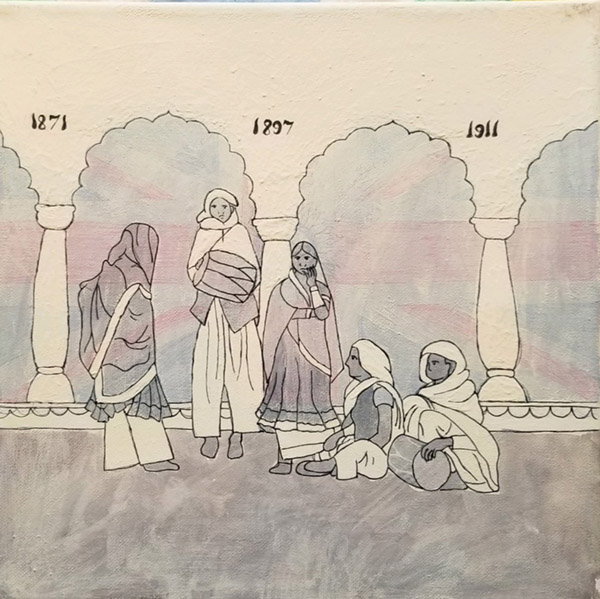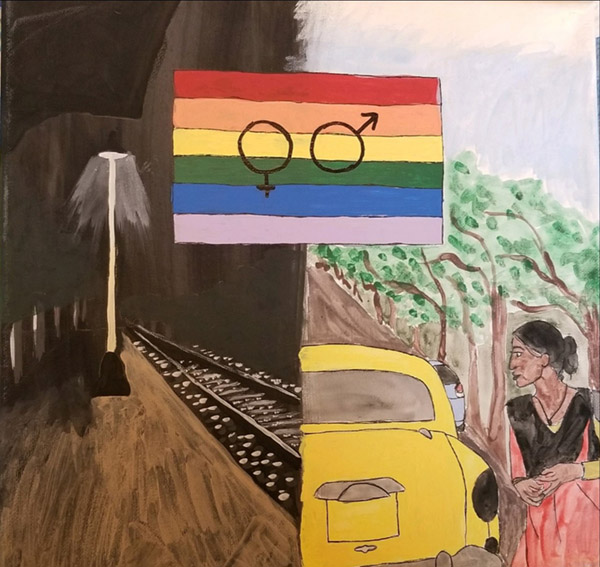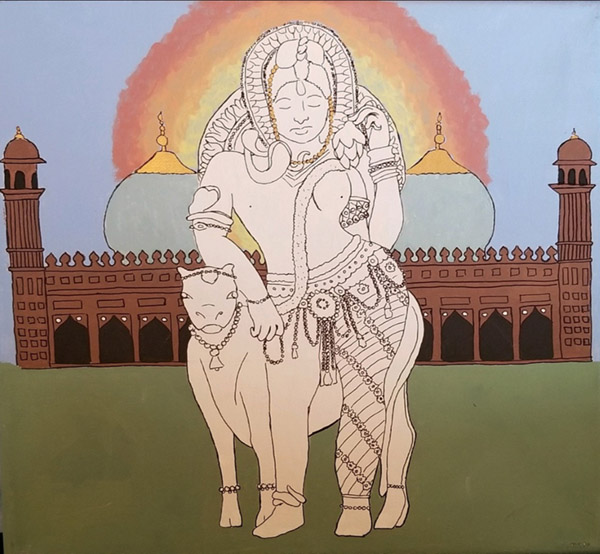Dani Thompson's Colonization Artwork
These paintings were done for Dr. Whitney Duncan’s Anthropology of Globalization class where students were asked to create an un-essay project which addressed the process of globalization on a topic of the student’s choosing.
I chose to address globalization through the westernization of global sex/gender system, with Indian third gender categories as the focus. Both historically and contemporarily, one term used for those who fit into the South Asian third gender category was and is Hijra, people whose lives are spent in the liminal spaces of society in terms of gender and their acceptance. In the past, those who identified as Hijras experienced elevated positions in society due to religious associations as devotees to Shiva and/or Bahuchara Mata. They often lived self-sustaining lives in small communities led by gurus (other Hijras) where they would devote themselves to worship as chelas (disciples) and traveled to other communities to offer badhai’s (blessings).
Through British imperialist efforts to enforce control over South Asia through ethnocide, many nomadic groups, including Hijra communities were criminalized through the Criminal Tribes Act which began a long line of laws that pushed Hijras further and further into the fringes of society. Like other queer communities all over the world, Hijras adapted to these restrictions to exist under the radar of British policy through tactics such as the creation of Hijra Farsi which served the same purpose as other secret languages such as Polari in the UK. Modern pushes for LGBTQ+ rights in the Western world have bled over to India in the form of more tolerant government policies which now formally recognizes third gender individuals to allow them access to education, healthcare, and employment. Despite this, life for many who identify as Hijras is still that of a second-class citizen. Often Hijras are seen begging on the street, exchanging badhai’s and performances for money or become a part of prostitution circles run by gurus.
The Transgender Persons Protection of Rights Act, which although benevolent sounding, further serves to marginalize third gender people by requiring trans people to undergo sex reassignment surgery as well as register with district magistrates as transgender and change their official documentation from male to female or vice versa. These modern pressures cloaked as attempts at progressive politics undermine the history of being a third gender individual in Indian culture. These paintings serve to expose the effects of colonialism still present in India which have not faltered from pushing Western understandings of gender and what is and is not acceptable in terms of how a person understands their own gender and how they may choose to express it.
Pre-Colonization
7500 BCE - 17th Century
Shiva merges with his wife, Parvati, to form the androgynous god Ardhanari (depicted).
Mentioned within the Kama Sutra and Mahabharata
Rama ordered all the men and women who were his subjects to leave the forest as he left, those who were neither waited 14 years for his return
All Hijra communities where chelas learn from gurus and devote their lives to worshipping Shiva and/or Bahuchara Mata
Elevated positions within Mughal courts as harem guards (palace depicted)
Michel, Paige. “History of the Hijra: Ancient India to Today.” Wessex Scene, February 27, 2019.

Colonization
18th Century - 1947
1700’s Britain colonized India through trade and by seizing land
1866 Section 377 Indian Penal Code criminalized sex “against the order of nature”
1871 Criminal Tribes Act which criminalized mobile tribes as well as Hijras due to travel involved with badhai’s
1897 Hijras criminalized as “breach of public decency” and through allegations of kidnapping and castration, required Hijras to be registered as habitual offenders
1911 Anti-Hijra provision of CTA repealed due to conceptions that Hijras had died out
Hijras adapt through the creation of Hijra Farsi, mixing clothing styles, and moving regions to avoid registration
The long history of criminalising Hijras. (2019, July 2).
Michel, Paige.
“History of the Hijra: Ancient India to Today.” Wessex Scene, February 27, 2019.

Post-Colonization - Today
1947-Present
1952 Habitual Offenders Act replaces the Criminal Tribes Act
2011 Anti-Hijra movement results in 100+ Hijra’s being arrested by Bangalore Police
2014 Indian Supreme Court formally recognizes third gender individuals to allow them access to education, healthcare, and employment
Hijras occupy marginalized spaces within society performing and giving out badhai’s on the side of the road
Hijra communities become prostitution circles where chelas work and give earnings to gurus in exchange for protection against customers and police
2019 Transgender Persons Protection of Rights Act
Gupta, Sonali. “The History of Hijras-South Asias Transsexual and Transgender Community.”
India.com, September 15, 2015. https://www.india.com/lifestyle/the-history-of-hijras-south-asias-transsexual-and-transgender-community-540754/.
The long history of criminalising Hijras. (2019, July 2). Retrieved from https://himalmag.com/long-history-criminalising-hijras-india-jessica-hinchy-2019/.
Hylton, S., Gettleman, J., & Lyons, E. (2018, February 17). The Peculiar Position
of Indias Third Gender. Retrieved from https://www.nytimes.com/2018/02/17/style/india-third-gender-hijras-transgender.html.


